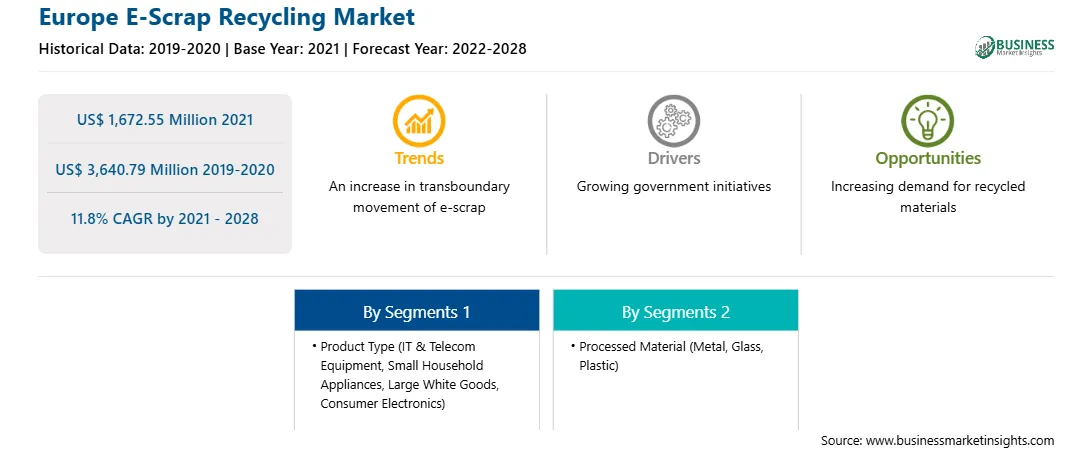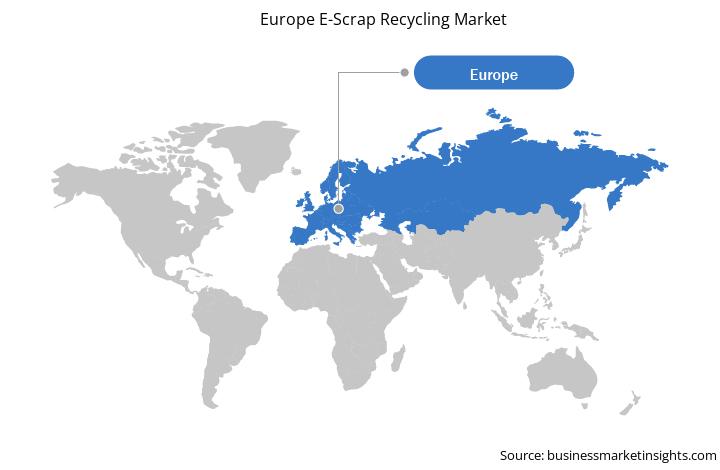The limited availability of rare metals, combined with their ever-increasing demand, has resulted in a rapid rise in their costs. Silver, gold, palladium, platinum, indium, and gallium are among the unique and precious metals found in e-waste. These rare elements are frequently employed in consumer electronics and IT and communication systems. Procuring such metals from e-waste and reusing them for another process is a major stream of revenue for players in the metals and other associated industries. For example, ~250 kg of silver, 24 kg of gold, may be recovered from one million mobile phone garbage. This would also benefit manufacturers by allowing them to build electrical gadgets at lower costs and gain a cost advantage over their competitors. The increasing demand for recycled metals is highlighting the need for reuse, refurbishment, and recycling of metal-based gadgets. This would also benefit countries in terms of reducing greenhouse gas emissions, which would assist in mitigating the threat of global warming. This is because, the carbon footprint of electronics, including smartphones, is about 3.7% of greenhouse emissions, around 14 ounces of carbon dioxide per person each year. Electronic equipment tends to become outmoded or require repair from time to time, which is a crucial contributor to e-waste generation. Replacing an electronic gadget is less expensive than having it fixed. As a result, there has been an increasing trend toward purchasing new products rather than repairing old ones. This necessitates the creation of an extensive network of collection zones for that electronic garbage that needs to be reused, refurbished, and recycled.
With the new features and technologies, vendors can attract new customers and expand their footprints in emerging markets. This factor is likely to drive the Europe e-scrap recycling market in the coming years. The market is expected to grow at a good CAGR during the forecast period.
The Europe e-scrap recycling market is segmented based on product type, processed material and country. Based on product type, the market is segmented into IT & telecom equipment, small household appliances, large white goods, consumer electronics, and others. The large white goods segment dominated the market in 2020 and IT & telecom equipment segment is expected to be the fastest growing during the forecast period. Based on processed material, the market is segmented into metal, glass, plastic, and others. The metal segment dominated the market in 2020 and is expected to be the fastest growing during the forecast period. Based on country, the Europe e-scrap recycling market is segmented into Germany, France, Italy, the UK, Russia, and the rest of Europe. DOWA HOLDINGS CO., LTD; Electronic Recyclers International, Inc; JX Nippon Mining & Metals Corporation; Sims Metal Management Ltd; Stena Metall Ab; Tetronics; and Umicore are among the leading companies in the market.
Strategic insights for the Europe E-Scrap Recycling provides data-driven analysis of the industry landscape, including current trends, key players, and regional nuances. These insights offer actionable recommendations, enabling readers to differentiate themselves from competitors by identifying untapped segments or developing unique value propositions. Leveraging data analytics, these insights help industry players anticipate the market shifts, whether investors, manufacturers, or other stakeholders. A future-oriented perspective is essential, helping stakeholders anticipate market shifts and position themselves for long-term success in this dynamic region. Ultimately, effective strategic insights empower readers to make informed decisions that drive profitability and achieve their business objectives within the market.

| Report Attribute | Details |
|---|---|
| Market size in 2021 | US$ 1,672.55 Million |
| Market Size by 2028 | US$ 3,640.79 Million |
| Global CAGR (2021 - 2028) | 11.8% |
| Historical Data | 2019-2020 |
| Forecast period | 2022-2028 |
| Segments Covered |
By Product Type
|
| Regions and Countries Covered | Europe
|
| Market leaders and key company profiles |
The geographic scope of the Europe E-Scrap Recycling refers to the specific areas in which a business operates and competes. Understanding local distinctions, such as diverse consumer preferences (e.g., demand for specific plug types or battery backup durations), varying economic conditions, and regulatory environments, is crucial for tailoring strategies to specific markets. Businesses can expand their reach by identifying underserved areas or adapting their offerings to meet local demands. A clear market focus allows for more effective resource allocation, targeted marketing campaigns, and better positioning against local competitors, ultimately driving growth in those targeted areas.

The Europe E-Scrap Recycling Market is valued at US$ 1,672.55 Million in 2021, it is projected to reach US$ 3,640.79 Million by 2028.
As per our report Europe E-Scrap Recycling Market, the market size is valued at US$ 1,672.55 Million in 2021, projecting it to reach US$ 3,640.79 Million by 2028. This translates to a CAGR of approximately 11.8% during the forecast period.
The Europe E-Scrap Recycling Market report typically cover these key segments-
The historic period, base year, and forecast period can vary slightly depending on the specific market research report. However, for the Europe E-Scrap Recycling Market report:
The Europe E-Scrap Recycling Market is populated by several key players, each contributing to its growth and innovation. Some of the major players include:
The Europe E-Scrap Recycling Market report is valuable for diverse stakeholders, including:
Essentially, anyone involved in or considering involvement in the Europe E-Scrap Recycling Market value chain can benefit from the information contained in a comprehensive market report.